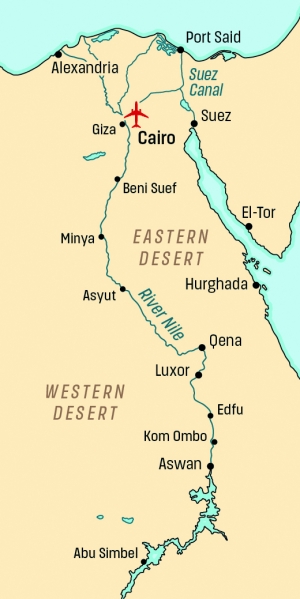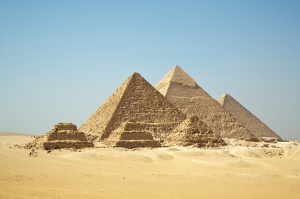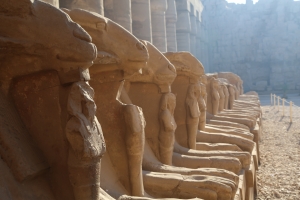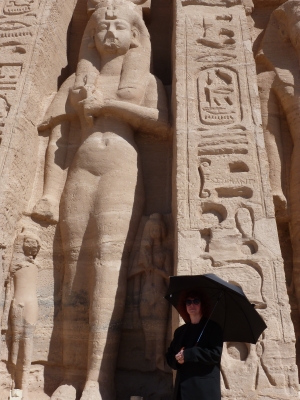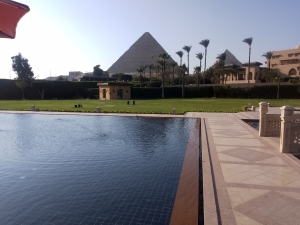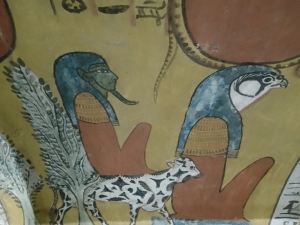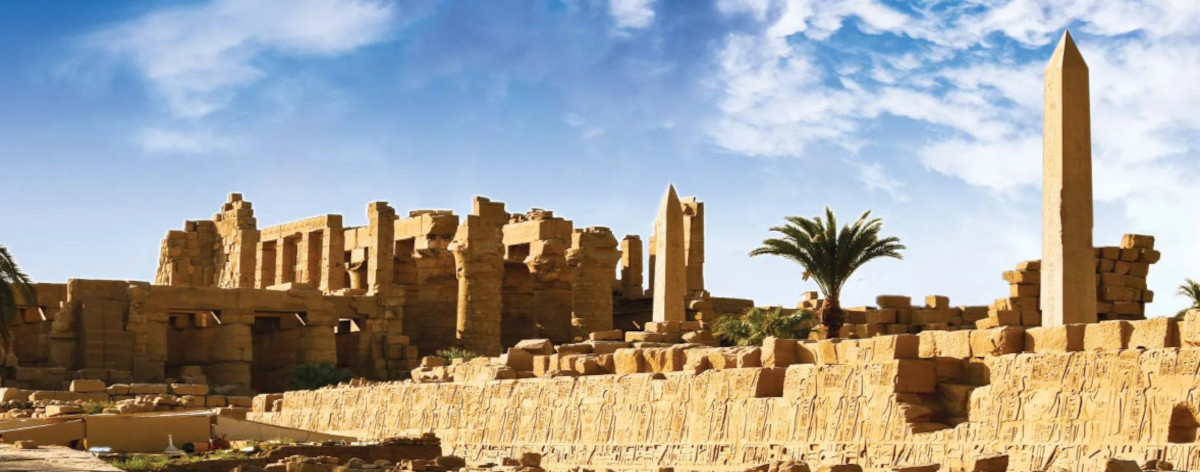
31st January - 9th February 2026
(10 Days)
Expert Historian : Professor Joann Fletcher
Tour price: £5,655
Your Holiday Essentials
31st January - 9th February 2026
(10 Days)
Four star or best available hotels, meals as indicated, drinks with dinner, all entrance fees, tour manager and expert historian throughout, optional travel from UK.
Expert Historian: Professor Joann Fletcher
Prices:
Standard price: £5,255
Incl. travel from UK: £5,655
Room sole occupancy supplement: £575
Booking open
Interested in this tour but not ready to book? Register your interest using the link below and we will keep you updated on the progress of the tour.
|
|
Tour Introduction
Egypt captures the imagination like no other destination. From the colossal pyramids at Giza and Saqqara through to the exquisite intimacy of its art and the beguiling lives (and deaths) of its rulers ancient Egypt is the gift that keeps on giving. We are therefore pleased to offer a tour which provides a fresh outlook on the archaeology, history, religion, art and distinctive way of life and death of this fascinating civilisation.
In the company of expert Egyptologist, author and tv presenter Professor Joann Fletcher we travel through an incomparably rich history and gain new perspectives on the sites and people who inhabited them. This is more a journey of discovery than mystery.
We are delighted that Professor Joann Fletcher, the expert historian who leads this journey, has recently been featured in the BBC series Civilisations: Rise and Fall, where she explores the remarkable world of ancient Egypt. Joann’s appearance showcases the depth of knowledge, insight, and engaging storytelling she brings to her work - the very qualities that make travelling with her such a rewarding experience. Guests on this tour will have the unique opportunity to explore Egypt’s monumental landscapes and archaeological wonders alongside one of the country’s most respected Egyptologists.
From Giza and Saqqara in the north we move south down the Nile Valley to enjoy the temples in Luxor and the tombs in Valley of the Kings before continuing to Edfu, Kom Ombu and Aswan. The tour culminates in an unforgettable trip to Abu Simbel.
Background
Since ancient times Egypt has rightly been called ‘the gift of the Nile’, whose rich alluvial soil made possible the rise of a legendary civilization in an otherwise desert landscape.
From Egypt’s earliest art created an astonishing 20,000 years ago to the development of farming around 5000 BC, some of the world’s first writing appeared in Egypt c.3250 BC to calculate the taxes due to local leaders. These leaders then competed among themselves for territory until only the regions of north and south remained, with northern ‘Lower’ Egypt and southern ‘Upper’ Egypt so named because of the south-north direction in which the Nile flows.
Around 3100 BC southern leader Narmer (aka Menes) eventually triumphed over his opponent in Lower Egypt to unite the country, this pivotal moment initiating a succession of 30 royal dynasties who ruled Egypt and its empire for the next 3000 years. These three millennia are now divided into the successive Old, Middle and New Kingdoms characterised by stability and prosperity, punctuated by spells of instability known as Intermediate Periods. The Old Kingdom (c.2686-2181 BC) is best known for the pyramid tombs of its rulers, from Egypt’s first pyramid at Saqqara to its most famous, the Great Pyramid of Giza, the last of the World’s Seven Wonders still standing today. Passing into the glories of the Middle Kingdom (c.1985-1650 BC), a time of exquisite art and literature, the Middle Kingdom pharaohs expanded Egypt’s empire abroad. Yet it is the New Kingdom (c.1550-1069 BC) which is best known today due to its famous pharaohs male and female who continued Egypt’s foreign expansion, at least until the so-called ‘Amarna Period’ when pharaohs Akhenaten, Nefertiti and Tutankhamun focused on religious reforms. Replacing the traditional gods with a new form of sun god in a policy so disastrous that Tutankhamun’s tomb was used to bury all trace of the Amarna Period, the golden contents of his tomb discovered in 1922 continue to reveal their secrets with ongoing study.
Despite the efforts of remaining New Kingdom pharaohs to keep their empire intact, Egypt’s power began to wane and during the first millennium BC it was taken over by a succession of Libyans, Nubians, Greeks and Romans. Yet such was the strength of Egypt’s ancient culture it conquered all such invaders who had themselves portrayed as pharaohs, adopted mummification and worshipped the gods of Egypt within temples they continued to build at places like Karnak, Edfu, Kom Ombo and Philae. Only when Rome’s empire adopted Christianity at the end of the C. AD 4th did all this change, as temples became churches or were closed down, the temple schools no longer able to teach the hieroglyphic language and the ancient sites gradually disappearing under drifting sands.
For over 1,400 years Egypt’s ancient past lay silent until hieroglyphs were finally deciphered in 1822, triggering the beginnings of excavations up and down the Nile Valley and allowing this immortal civilisation to re-emerge into the modern world.
Highlights
- Travel in the company of an expert Egyptologist, author and tv presenter
- Enjoy 3 nights in the 5-star Marriott Mena House, Cairo - the famous frequent stop for dignitaries and celebrities overlooking the Great Pyramids of Giza
- Enjoy special visits to sites not normally open to the public
- Visit the spectacular pyramids at Giza and Saqqara
- Capture the unique atmosphere of ancient Egypt at the temples of Luxor, Karnak and Abu Simbel
- Visit the unforgettable Valleys of the Kings and Queens and Temple of Hatshepsut
- Enjoy Egypt’s excellent museums including the now fully opened Grand Egyptian Museum and the Museum of Egyptian Civilisation
- Soak up the stunning landscapes of the beautiful Nile Valley
What's Included
- 4 & 5 Star Hotels
- Return flights from London (optional)
- Expert historians throughout providing a daily variety of talks, presentations and Q&A
- Internal flight(s)
- Dedicated Tour Manager
- The company of like-minded travelers
- Helpful and friendly travel advice
- Meals as indicated in the itinerary
- Soft drinks with dinner
- Entrance fees for sites included in itinerary
- Tour information booklet
- Modern, comfortable, air-conditioned coach
"From the heights of these pyramids, forty centuries look down on us"
Napoleon Bonaparte at the Battle of the Pyramids (1798)
Itinerary
Day 1 - Arrival: Fly London to Cairo or make your own arrangements to join the tour at the hotel. Hotel in Cairo – 2 nights.
Day 2 - Beginnings - Memphis and Saqqara: We start our exploration of Egypt’s ancient past at the city of Memphis, capital of Egypt during both the Early Dynastic Period and Old Kingdom and believed to be under the protection of the god Ptah. We then travel the short distance to Saqqara, home of the very first pyramid created for King Djoser c.2650 BC by his architect Imhotep. Surrounded by protective walls, the funerary complex within is made up of some of the world’s oldest stone buildings and features chapels, shrines, halls and even a pharaonic racetrack. After a relaxing lunch we visit the National Museum of Egyptian Civilisation, whose Royal Mummies Gallery is home to some of Egypt’s greatest rulers originally buried in the Valley of the Kings. (B, L, D).
Day 3 - The Grand Egyptian Museum: Today we visit the incredible Grand Egyptian Museum – now fully opened – and considered the largest archaeological museum on earth. Here for the first time all the tomb contents of Tutankhamun are displayed alongside an astonishing wealth of artefacts from the whole of ancient Egyptian civilisation. We then move to the ‘old’ Egyptian Museum in central Cairo with its rich collection of ancient Egyptian artefacts many of which are seen for the first time. With both museums displaying Egyptian history from prehistoric times up to the Ptolemaic period, this is the perfect way of putting our whole trip into context and fully appreciating the astonishing legacy of this immortal civilisation. An evening flight brings us to the beautiful riverside city of Luxor where we check in to our comfortable hotel. Hotel in Luxor – 3 nights. (B, L, D).
Day 4 - Luxor – Temples along the Nile: Luxor is very much an openair museum, home to some of Egypt’s most iconic sites which we will explore over the next two days. In the morning we visit the Karnak Temple with its vast complex of pylons, chapels, obelisks, statues and lakes. Here we admire the famous Hypostyle Hall with its ‘forest’ of colossal papyrus-shaped columns. We then move on to the Luxor Museum, whose superb collection of objects comes from the Karnak and Luxor temples and the tomb of Tutankhamun. After lunch we enjoy some well-earned rest time giving us the opportunity to escape from the heat of the day. In the late afternoon we embark upon a gentle felucca (sailing boat) trip on the Nile to enjoy the changing play of light on the surrounding landscape. We then visit the beautifully proportioned Temple of Luxor built by successive New Kingdom pharaohs Hatshepsut, Amenhotep III and Ramses II with additions by Alexander the Great. Its Avenue of Sphinxes connects to the temple of Karnak almost 3km to the south. (B, L, D).
Day 5 - The Valley of the Kings and Queens: We cross the River Nile to its West Bank to spend a full day exploring some of the most famous royal cemeteries in the world. With our first stop the legendary Valley of the Kings, burial site for New Kingdom rulers (c.1500-1100 BC) including Tutankhamun, his tomb and its golden contents remain the most famous archaeological discovery of all time. We also make a special visit to the tomb of Amenhotep III, only recently opened to the public. We now move to the funerary temple of Pharaoh Hatshepsut, an architectural masterpiece from the 15th Century BC which later inspired architects from ancient Greece to the Art Deco movement. After lunch we move to the nearby Valley of the Queens - where queens, princes, princesses, and high-ranking officials were buried - and visit several examples of tombs from the 18th Dynasty onwards. Our next visit is to the workmen’s village at Deir el-Medina where we learn of the everyday lives of the artisans who helped build the lavish tombs in the region. Here we make a special visit to the exquisite tomb of Kha and Meritt, one of the best preserved non-royal tombs in ancient Egypt. Our return to Luxor takes us past the enormous Colossi of Memnon, familiar figures since the mid-14th Century BC These are endowed with Greek and Latin inscriptions and have recently been joined by several more sets of the king's newly excavated colossal figures. (B, L, D).
Day 6 - Edfu and Kom Ombo: Leaving Luxor we travel south by coach down the Nile valley, whose lush riverside landscapes contrasting with barren desert cliffs emphasise the dual nature of the ancient culture. This relaxing journey also gives opportunities to stop and admire local scenery and the occasional shaduf, the hand-operated water-lifting device in use since ancient times. At Edfu we’ll tour the spectacular Temple of Horus, one of the best preserved in Egypt complete with its library and laboratory chambers and images of the Ptolemaic Greek Dynasty who built it (237-57 BC). Then continuing south to Kom Ombo, we visit a temple again created by the Ptolemies yet uniquely dedicated to two gods, Horus the falcon and Sobek the crocodile. The museum of mummified crocodiles here demonstrates the reverence ancient Egypt held for these dangerous beasts. Arriving at Aswan we check in to our hotel for 3 nights. (B, L, D).
Day 7 - Into Nubia - Aswan: During a day spent in Aswan we visit the island of Philae, ‘Pearl of the Nile’, to visit the atmospheric Temple of Isis, the very last place the ancient gods were being worshipped into the 6th Century AD long after the coming of Christianity. We then move to the nearby Column Quarry to marvel at the size of the Unfinished Obelisk, the largest ever attempted at 137 feet long before driving to the Aswan Dam beyond which the rising waters of the vast Lake Nasser submerged hundreds of ancient sites during the 1960s, including Abu Simbel. In the afternoon we enjoy a further felucca trip to the Elephantine Island with its Satis and Khunum temples and museum. These were temples to the gods who controlled the annual Nile flood and one of Egypt’s oldest Nilometers constructed here to measure ancient flood levels is found here. (B, L, D).
Day 8 - Abu Simbel: An early start today to drive by coach to the rock-cut temples of Abu Simbel. Although threatened by the rising waters of Lake Nasser in the 1960s, the two colossal temples were raised 60 metres up to their present site in a remarkable feat of archaeological preservation. Originally built by Ramesses II (1279–1213 BC), the larger temple is dedicated to the male gods Amon-Ra, Ra-Horakhty, Ptah and Ramses himself, with the second temple dedicated to Ramses’ favourite wife Nefertari and Hathor, goddess of love and beauty. Return by coach to Aswan enjoying the stunning desert scenery. (B, L, D).
Day 9 - Cairo and Giza: An early flight today back to Cairo to arrive at our hotel by mid-morning. And having seen Egypt’s oldest pyramid at Saqqara, we now move on to its most famous, the three pyramids of Giza (c.2570-2500 BC), whose enormous scale is testament to the skills of the workers who built them and lived close by. We’ll also see the Great Sphinx who has watched over this trio of royal tombs for the last four and a half thousand years while witnessing over a million and a half sunrises. (B, L, D).
Day 10 - The Khan el-Khalili Bazaar and depart: Our final day in Egypt. En route to the airport we’ll take the opportunity to visit the amazing Khan el-Khalili Bazaar where artisans still manufacture traditional crafts and souvenirs. Dating from Mameluke times (AD C.14th–15th), this huge souq is well known for its superb caravanserais – inns for merchants – which are used as shops and workshops to this day. Fly Cairo to London early evening or perhaps extend your stay in Egypt. (B, L).
Recommended Reading List

Professor Joann Fletcher
Professor Joann Fletcher is based in the Department of Archaeology at the University of York and is Lead Ambassador for the Egypt Exploration Society. Having first visited Egypt in 1981, her research interests include the 18th dynasty, Cleopatra VII and the Ptolemies, mummification, personal adornment and ancient wine production. As a passionate advocate for the preservation and promotion of culture and heritage in her native Yorkshire, Jo has worked on excavations in the UK, in Egypt and in Yemen, and having undertaken research in museums around the world also curates museum exhibitions. She has published extensively on Egypt, the Near East and Greece both in archaeological and scientific journals, and as consultant to several international publishers has so far published 10 books translated into 7 languages, including 'The Story of Egypt', 'Cleopatra the Great' and 'The Search for Nefertiti' (all Hodder & Stoughton). She’s won a BAFTA, Royal Television Society Award and an award from the Association for International Broadcasting, and has written and presented several series for the BBC including 'Ancient Egypt: Life and Death in the Valley of the Kings', ‘Egypt’s Lost Queens’ and 'Immortal Egypt with Joann Fletcher'. For more see: About | Immortal Egypt
Your Holiday Essentials
31st January - 9th February 2026
(10 Days)
Four star or best available hotels, meals as indicated, drinks with dinner, all entrance fees, tour manager and expert historian throughout, optional travel from UK.
Expert Historian: Professor Joann Fletcher
Prices:
Standard price: £5,255
Incl. travel from UK: £5,655
Room sole occupancy supplement: £575
Booking open
Interested in this tour but not ready to book? Register your interest using the link below and we will keep you updated on the progress of the tour.
|
|

